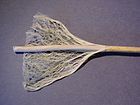- Natural fiber
-
Fibers or fibres (see spelling differences) are a class of hair-like materials that are continuous filaments or are in discrete elongated pieces, similar to pieces of thread. They can be spun into filaments, thread, or rope. They can be used as a component of composite materials. They can also be matted into sheets to make products such as paper or felt. Fibers are of three types: natural fiber, cellulose fiber, and synthetic fiber. The earliest evidence for humans using fibers is the discovery of wool and dyed flax fibers found in a prehistoric cave in the Republic of Georgia that date back to 36,000 BP.[1][2]
Contents
Sources
Natural fibers are made from plant, animal and mineral sources. Natural fibers can be classified according to their origin.
Vegetable fibers
 A strand of cellulose (conformation Iα), showing the hydrogen bonds (dashes) within and between cellulose molecules.
A strand of cellulose (conformation Iα), showing the hydrogen bonds (dashes) within and between cellulose molecules.
Vegetable fibers are generally composed mainly of cellulose: examples include cotton, jute, flax, ramie, sisal, and hemp. Cellulose fibers serve in the manufacture of paper and cloth. This fiber can be further categorized into the following:
Category Description Seed fiber Fibers collected from seeds or seed cases. e.g. cotton and kapok Leaf fiber Fibers collected from leaves. e.g. fique, sisal, banana and agave. Bast fiber Fibers are collected from the skin or bast surrounding the stem of their respective plant. These fibers have higher tensile strength than other fibers. Therefore, these fibers are used for durable yarn, fabric, packaging, and paper. Some examples are flax, jute, kenaf, industrial hemp, ramie, rattan, and vine fibers. Skin fiber Fruit fiber Fibers are collected from the fruit of the plant, e.g. coconut (coir) fiber. Stalk fiber Fibers are actually the stalks of the plant. E.g. straws of wheat, rice, barley, and other crops including bamboo and grass. Tree wood is also such a fiber. The most used vegetable fibers are cotton, flax and hemp, although sisal, jute, kenaf, bamboo and coconut are also widely used.
Hemp fibers are mainly used for ropes and aerofoils because of their high suppleness and resistance within an aggressive environment. Hemp fibers are, for example, currently used as a seal within the heating and sanitary industries.
Animal fibers
Animal fibers generally comprise proteins such as collagen and keratin; examples include silk, sinew, wool, catgut, angora, mohair and alpaca.
- Animal hair (wool or hairs): Fiber or wool taken from animals or hairy mammals. e.g. sheep's wool, goat hair (cashmere, mohair), alpaca hair, horse hair, etc.
- Silk fiber: Fiber collected from dried saliva of bugs or insects during the preparation of cocoons.
- Avian fiber: Fibers from birds, e.g. feathers and feather fiber.
Industrial usage
After World War II, the build-up of synthetic fibers significantly decreased the use of natural fibers. Now, with the increase of oil prices and environmental considerations, there has been a revival of natural fiber use within the textile, building, plastic and automotive industries[citation needed]. This interest is reinforced by the developmental perspectives on the agro-industrial market and local productions, allowing economic development and independence versus imported materials.
France remains the greatest European hemp fiber producer with 50,000 tons yearly (EU 100,000 tons). France also produces the largest range of industrial seeds worldwide. China and Russia are also important producers, but the statistics in that field are not available.[citation needed]
In the industrial domain, the consortium DAIFA group SAS have reached a leading position in Europe in the automotive plastics market. [1] They specialize in injection and thermopress plastics reinforced with natural fibers.
The use of natural fibers at the industrial level improves the environmental sustainability of the parts being constructed, especially within the automotive market. Within the building industry, the interest in natural fibers is mostly economical and technical; natural fibers allow insulation properties higher than current materials.[citation needed]
See also
- Fiber
- International Year of Natural Fibres 2009
References
- ^ Balter M. (2009). Clothes Make the (Hu) Man. Science,325(5946):1329.doi:10.1126/science.325_1329a
- ^ Kvavadze E, Bar-Yosef O, Belfer-Cohen A, Boaretto E,Jakeli N, Matskevich Z, Meshveliani T. (2009).30,000-Year-Old Wild Flax Fibers. Science, 325(5946):1359. doi:10.1126/science.1175404 PMID 19745144 Supporting Online Material
In the United States in 2009 over 50 million pounds of kenaf were grown. The states with the highest amount of kenaf production in 2009 were North Carolina, Georgia and Mississippi. The harvested kenaf is about 65% core material and about 35% bast fiber.
External links
Classification of natural fibers and list of bast fibers
Fibers Natural 
Synthetic CelluloseCategories:- Fibers
Wikimedia Foundation. 2010.
